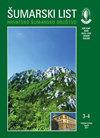The morphological and chemical variability of Turkish Hazel (Corylus colurna L.) fruits in Turkey
IF 0.4
4区 农林科学
Q4 FORESTRY
引用次数: 0
Abstract
Turkish hazel (Corylus colurna L.) is naturally distributed in southeast Europe, Anatolia, the Caucasus and Western Himalayas. In Turkey, there are many isolated populations in the Black Sea, Marmara, Aegean, and Central Anatolian Regions. Many of the small populations in Turkey are endangered. In this study, the morphological and chemical characteristics of Turkish hazelnut fruits collected from seven populations were researched. In this regard, considering the morphological characteristics of fruits and kernels, significant differences were observed between the populations. Length, width, thickness, and weight averages were 15.98 mm, 15.38 mm, 12.00 mm and 1.4651 g in the fruits, and 13.03 mm, 11.22 mm, 7.64 mm and 0.5047 g in the kernels, respectively. The average shell thickness was 1.92 mm, shell weight was 0.9604 g, and kernel ratio was 35.16%. Statistically significant differences were found out between the populations whose chemical contents were analyzed. As a result of the analysis, the average fat content, protein, starch, and ash were 64.1%, 15.9%, 10.2 g, and 2.5%, respectively. According to the averages in the obtained fatty acids, the main fatty acids were oleic acid (79.53%), linoleic acid (11.34%), palmitic acid (5.68%), and stearic acid (2.03%), while the rest of other oils were found in trace amounts. Overall, our results suggest that the information relating to morphological and chemical characteristics of Turkish hazelnut can be useful for discriminating among populations.土耳其榛子(Corylus colurna L.)果实的形态和化学变异
土耳其榛子(Corylus colurna L.)自然分布于东南欧、安纳托利亚、高加索和喜马拉雅山脉西部。在土耳其,黑海、马尔马拉海、爱琴海和安纳托利亚中部地区有许多与世隔绝的人口。土耳其的许多小种群都濒临灭绝。本研究对采自7个群体的土耳其榛子果实的形态和化学特性进行了研究。在这方面,考虑到果实和籽粒的形态特征,观察到种群之间的显著差异。果实的长、宽、厚和重的平均值分别为15.98毫米、15.38毫米、12.00毫米和1.4651克,籽粒的平均值为13.03毫米、11.22毫米、7.64毫米和0.5047克。平均壳厚1.92毫米,壳重0.9604克,粒率35.16%。作为分析的结果,平均脂肪含量、蛋白质、淀粉和灰分分别为64.1%、15.9%、10.2g和2.5%。根据获得的脂肪酸的平均值,主要的脂肪酸是油酸(79.53%)、亚油酸(11.34%)、棕榈酸(5.68%)和硬脂酸(2.03%),而其他油的含量为微量。总之,我们的研究结果表明,与土耳其榛子的形态和化学特征有关的信息可以用于区分种群。
本文章由计算机程序翻译,如有差异,请以英文原文为准。
求助全文
约1分钟内获得全文
求助全文
来源期刊

Sumarski List
FORESTRY-
CiteScore
0.90
自引率
20.00%
发文量
32
审稿时长
>12 weeks
期刊介绍:
Forestry Journal publishes scientific and specialist articles from the fields of forestry, forestry-related scientific branches, nature protection and wildlife management.
 求助内容:
求助内容: 应助结果提醒方式:
应助结果提醒方式:


